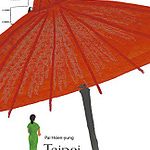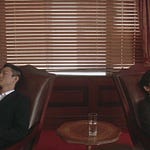Welcome to the inaugural post of Electric Dreams, an accompanying newsletter to my podcast, The Electric Image Express. Lets start by answering some questions you might have:
What is the Electric Image Express? If you’re here, you probably came from The Electric Image Express, but to refresh your memory: The podcast is a conversation around an Asian-American issue (how we deal with love, family, splintered identity, representation, etc.) framed by revisiting a culturally influential Asian or AAPI movie.
Why did you start this project? Because I care a lot about Asian American representation in media and wanted to celebrate these movies that had a profound impact on my life and the lives of many Asian Americans. Asian American identity does not live in a vacuum of course, and I aim to address other racial issues around living as a minority anywhere in the world.
How does Electric Dreams fit? My goal with Electric Dreams is to provide you with expanded thoughts on 1-2 concepts discussed in the podcast. To get the full experience, listen to the episode first (which I will include at the top) and then read.
What’s an Asian-American movie? For the intention of this podcast and newsletter, my definition of “Asian American Cinema” is pragmatic. Any movie that features Asian American protagonists and/or tells an Asian American story is fair game.
Why should I subscribe? If you enjoyed the podcast, subscribing helps get the podcast and my writing delivered right to your inbox. No need to check Spotify or Apple podcasts. If you enjoy reading rather than listening, my writing will give you a better idea of what to expect before committing 45-60 minutes on an episode. Finally, subscribing is the best way to support my work. :)

In this week’s episode I’m joined by long time animation industry veteran and good friend Stephanie Cheng as we revisit Big Hero 6 and discuss the state of Asian-American representation in animation.
Until the last couple years Asian Americans were faced with little opportunity to see ourselves on screen and even fewer chances to hear our stories. Virtually all Asian American film today tell a story critical to our identity (and rightfully so). Crazy Rich Asians and The Farewell reminded us that our western values don’t always fit in our motherland. The Big Sick showed us how to deal with a clash between a love for our culture and our partners. Better Luck Tomorrow pistol whipped the Model Minority Myth right in the face.

If I ran the Asian American film canon like the Marvel Cinematic Universe, our current crop of films would be Phase 1: Our Origin Story. Through these films we familiarize the global audience with AAPI issues and cultural norms. When movie audiences understand Asian Americans as well as they understand Asgardians writers can feel less obligated to wrap the plot around their culture. In Phase 2, our current movies would become one of many genres with Asian American leads and in Asian American worlds. (And dare we strive for a #starringjohncho Phase 3?)
Big Hero 6 gives us a glimpse into Phase 2. It’s not a story that needs an Asian American cast and world, but gives us one anyway. Hiro’s story arc doesn’t involve mastering karate, or resolving an internal clash of cultures. The non-Asian characters pronounce Hiro and Tadashi’s name with ease, don’t balk when given their own Japanese nicknames and Aunt Cass can whip up some fried rice as easily as she serves hot wings. San Fransokyo exists without explanation as a gleaming symbol of optimism to a future of mainstream integration and acceptance of Asian culture. (I spent 30 minutes coming up with other Asian-American cities in this universe. The best I got was Los Angeseoul)
Does it matter that Big Hero 6’s creative leads were all white males? In Episode 5 Eric and I agreed that while it is possible for non-AAPI to tell an AAPI story accurately, in practice it is very very hard. Stephanie believes we need to strive for a future where anyone can feel empowered to tell anyone else’s story. I would certainly be more excited to see non-AAPI minorities given the opportunity, but Big Hero 6’s well-researched execution earns it a lot of leeway.
By sheer luck, Big Hero 6 allows us to start this written portion of our journey on an optimistic foot. Any Asian would take some good ol’ fashioned auspiciousness, but it’s you the dedicated supporter who gives us our real luck. Thank you for your continued encouragement, participation, and feedback. It means the world to us.
Further Reading:
A History of Asian, South Asian, and Pacific Islander Characters in Disney Films by Christian Kim













Share this post